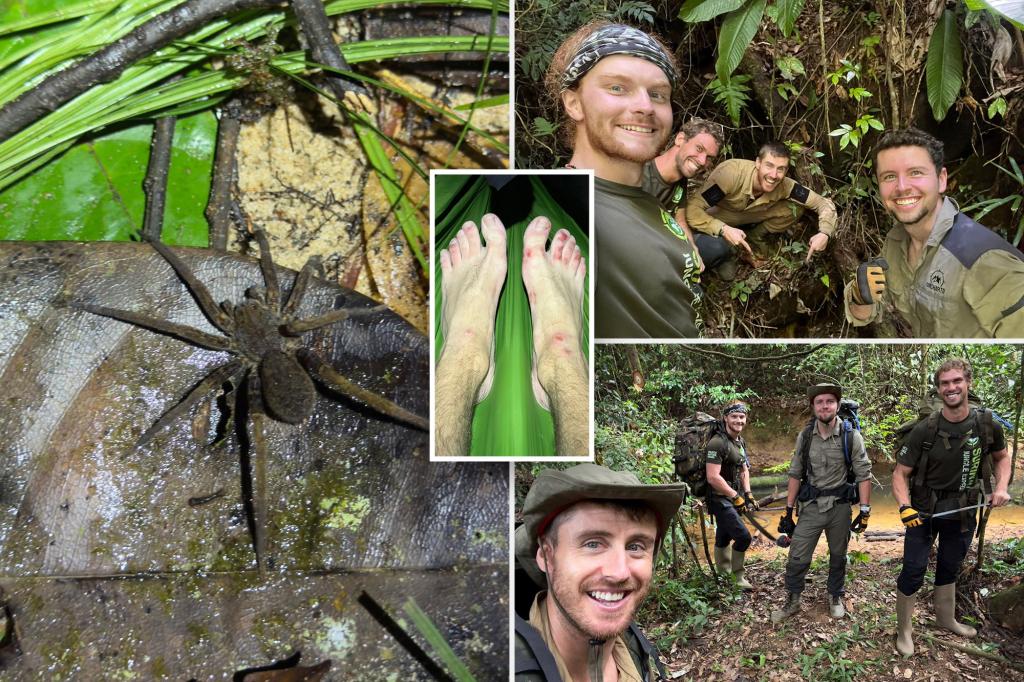Ticks, tarantulas and unchartered territory, oh my!
A UK explorer has discovered the source of an uncharted Amazon river and two waterfalls, accomplishing this feat all while being stalked by a jaguar and attacked by insects, SWNS reported.
Ash Dykes, along with fellow adventurers Jacob Hudson, Dick Lock and Matt Wallave, were “screaming and getting excited” when they found the start of the Coppename River in Suriname.
“We’ve mapped the coordinates and took a screenshot for any mapping associations who want that,” Dykes said.
“It is crazy to think that we are going to some places that the forest hasn’t ever seen a human footprint before. And it’s not surprising … It is brutal in the jungle.”
The band of brave voyagers then earned a world record the following day by becoming the fastest group to ascend Julianatop, the tallest mountain in the South American country.
They also named two undocumented waterfalls — ‘Dykes Falls’ and ‘Wallace Falls’ — named after the team members who first spotted them.
Dykes, 33, originally from St. Asaph, Wales, but now based in London, headed into the thick center of the ex-Dutch colony, which is 93% forested, in a helicopter on Aug. 29.
They then spent the next six days fighting their way upstream in kayaks with roughly 110 pounds of supplies.
As if that wasn’t challenging enough, they made this daring journey while being bitten by 300 ticks and brutal army ants.
The daring explorers had to endure other trials on their expedition, coming across a goliath tarantula — the world’s largest spider — as well as snakes and caiman, vicious reptiles related to alligators.
Dykes said the expedition had taken a toll on his feet, and that he had lost three toenails during the first section of the journey.
But Dykes said the most terrifying moment of all was when they awoke to find fresh jaguar poo, just yards from their tarpaulin-covered hammocks.
“We couldn’t see it, but who knows how long it was potentially following us for, following our tracks to camp,” Dykes said. “Seeing jaguar poo … was pretty creepy.”
He added that in addition to a scorpion paying them a visit, army ants took over the camp, forcing the four daring men to stand at the side of the river bank, “waiting for them to pass.”
One team member, Jacob, got hit with the merciless insects, and literally “had ants in his pants.”
Dykes said his team survived on 500 to 600 calories a day via ration packs and wolf fish they caught in the river.
The expedition had left them “cut up” and “bruised” from trekking up to 16 and a half hours at a time.
But the team was overjoyed to name two waterfalls they discovered on their expedition.
“We were pretty cut open and bruised for the majority of the first two days, and that’s when we came across an undiscovered waterfall — called ‘Wallace Falls’,” Dykes said.
That was named for Matt Wallace, who was the team member who first saw it, so “he claimed it and named it,” Dykes said.
He added that it was a 49-foot waterfall that “stopped us in our tracks.
“Matt Wallace, who was the team expedition member who saw it first, he claimed it and named it.
“It’s a big 15m falls that stopped us in our tracks,” Dykes said, adding that it is not on any GPS.
“We discovered a smaller falls right near the source, which I named ‘Dykes Falls’, and that one is even more remote,” Dykes said.
Dykes said those falls are “probably 100m from the source of the Coppename River.”
The finds of Suriname’s largely unexplored jungle are a major discover, since the dense interior has barely been explored since Victorian missions failed due to disease and injury in the 1800s.
Dykes said one of the most salient aspects of the expedition was the lack of any signs of civilization.
“It’s crazy remote here,” Dykes said. “We’ve not seen another human at all or any signs of another human.”
The team hopes to break another world record by climbing Suriname’s second-highest peak along the way in the fastest time.
Dykes has three previous world records following his expeditions in Mongolia, Madagascar and China.
“I kind of think it’s almost in my DNA,” Dykes said. “There’s no dark or bad upbringing story.”
